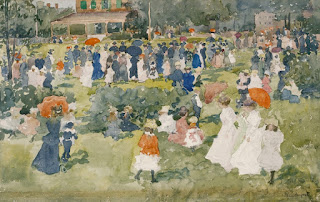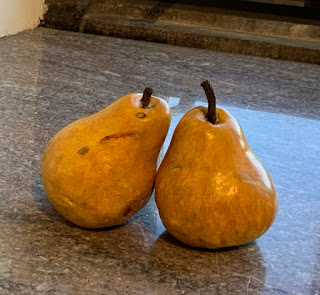Spiral, 74 x 74, acrylic, graphite, pumice medium on canvas
\
Even when Chicago artists aren’t delineating figures, they’re still looking outward, not inward - and they offer as much tension and noticeable craftsmanship as the Imagists. Miyoko Ito (1918-1983) , Barbara Rossi (1940-2023), Candida Alvarez (b.1955), and Magalie Guerin (b. 1973) might serve as examples. They depict objects in the world - even if unrecognizable. And those objects are accompanied by attitudes of satire or puzzlement or humor or wonder or whatever. Always intense - always personal. Deeply so. That’s the Chicago way.
In this show, however, Scott Wolniak (b. 1971) goes in nearly the opposite direction.
Pieces are indeed well made - but they feel more casual,- even passive. Shapes float rather than assert - and they seem to be appearing on their own - like moisture stains or cracks in a wall. There is no provocative personality here - just acceptance. Like George Harrison’s "Life flows on within you and without you".
The title of the exhibit, "Aggregations", refers to how the paintings were made in layers. First, a flat pattern of hollow tubing was sketched in - usually as a spiral. Then, like sausage casings, they were filled in with a variety of stuff: splotches, marks, lines, whatever. The piece as a whole may feel tired and boring. In a museum or gallery with hundreds or thousands of works to see, I would walk right past them. But often there is a quirky beauty in areas of detail. It’s not a beauty that slaps you in the face. It’s just that whenever you look for it - there’s a surprising variety of textures, surfaces, and marks that feel unpredictable and is echoed, in some way, across the canvas. It’s just what is needed for pieces one sees every day - in home or office.
The results are the same calm you might feel from Persian carpets - and they likewise share an inexorable pull from the edges towards the center. Chicago art is notably high spirited. These paintings are more like meditational/spiritual.
Some of them might serve well as mandalas at a yoga retreat - but they aren’t really targeted at any one specific spiritual practice. Wolniak teaches in the visual art department at the University of Chicago so he makes conceptual installations as well. ( 2009 : "Ungray: Color, Light, and Other Balms" at the Cultural Center). We might then think of his work as being about spirituality - in an intellectual way - rather than actually being part of a spiritual practice. Experimentation is more important than rectitude or enlightenment. Which does not mean that they necessarily look better or worse than what might be found in a Tibetan monastery. Though they do feel less serious. Unity with the spirit of the cosmos is not at stake.
In the history of American Art, this is the Hieroglyphic tradition of New York in the 1940’s - except that there seems no suggestion that the marks relate to ancient or esoteric symbols. The art theory has changed more than the painting.
Adolph Gottlieb, Masquerade, 1945
This piece comes the closest.
Allium, 36 x 30, acrylic, oil, pumice medium, fiber paste on canvas
Detail
What a wonderfully watery piece
even if muddy/murky in some areas.
It’s pulled every which way - and loose.
There seems to be a driving principle behind it’s organization-
but I know I will never find it.
Walk in the Park, 21 x 17, acrylic, oil, pumice medium, fiber paste on canvas
The least spiritual, and most enjoyable piece in the show
Might serve as the cover for a Brian Eno album.
I’ m guessing that the title is an afterthought.
Detail
Maurice Prendergast, Franklin Park, Boston, 1895
Here’s another stroll through a park.
On the other hand, the pieces in Wozniak’s 2023 show. "Cross currents", at Goldfinch Gallery were quite different:
Radish, Et Al,” 2022, acrylic, graphite, paper pulp and pumice medium on canvas, 72″ x 60″
It also resembles a Tibetan thangka, but it’s more like a figurative one - even if it has no recognizable figures.
The Resplendent One, 14th Century
Going back to his 2014 show at Valerie Carberry,
we find the wild, chaotic intensity of an early modernist like Pavel Filonov:
Current, 2014, Acrylic, ink, and watercolor on carved plaster, burlap , and plywood., 24 x 21
Now this is more like Chicago art.
It’s something Bruce Thorn might do.
Clearly Scott Wolniak is moving in an ever more spiritual/meditational direction and I look forward to seeing a retrospective someday. He might even end up with the emptiness of Malevich or Rothko - but his response to nothingness would probably be to start automatically filling it up with something, anything. It’s called horror vacui.
*****
.
This show also includes these small sculptures:
Wolniak has taken his lumpy shapes off the wall and made them sculptural objects. Now their value is entirely conceptual. These painted plaster casts are so realistic that indeed wild birds might peck at them ( remember Zeuxis of Heraclea? ) They are indeed humorous.- but their forms are as disposable as the overripe fruit they represent. I’m sure the janitorial staff had to be cautioned not to pitch them in the garbage.














No comments:
Post a Comment